Haowen Sun
PointVDP: Learning View-Dependent Projection by Fireworks Rays for 3D Point Cloud Segmentation
Jul 09, 2025Abstract:In this paper, we propose view-dependent projection (VDP) to facilitate point cloud segmentation, designing efficient 3D-to-2D mapping that dynamically adapts to the spatial geometry from view variations. Existing projection-based methods leverage view-independent projection in complex scenes, relying on straight lines to generate direct rays or upward curves to reduce occlusions. However, their view independence provides projection rays that are limited to pre-defined parameters by human settings, restricting point awareness and failing to capture sufficient projection diversity across different view planes. Although multiple projections per view plane are commonly used to enhance spatial variety, the projected redundancy leads to excessive computational overhead and inefficiency in image processing. To address these limitations, we design a framework of VDP to generate data-driven projections from 3D point distributions, producing highly informative single-image inputs by predicting rays inspired by the adaptive behavior of fireworks. In addition, we construct color regularization to optimize the framework, which emphasizes essential features within semantic pixels and suppresses the non-semantic features within black pixels, thereby maximizing 2D space utilization in a projected image. As a result, our approach, PointVDP, develops lightweight projections in marginal computation costs. Experiments on S3DIS and ScanNet benchmarks show that our approach achieves competitive results, offering a resource-efficient solution for semantic understanding.
Ambiguity-aware Point Cloud Segmentation by Adaptive Margin Contrastive Learning
Jul 09, 2025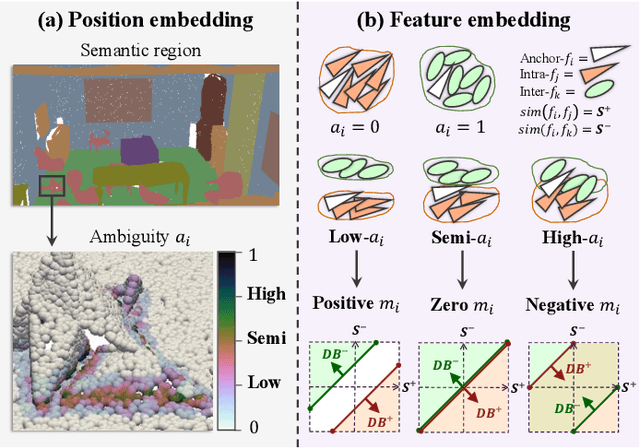
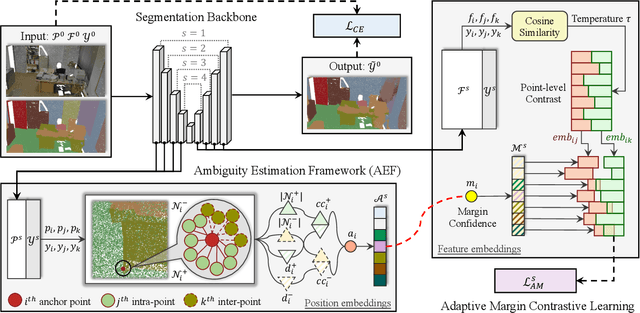
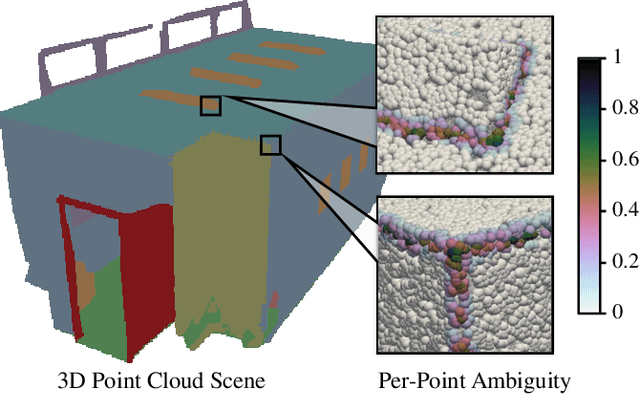
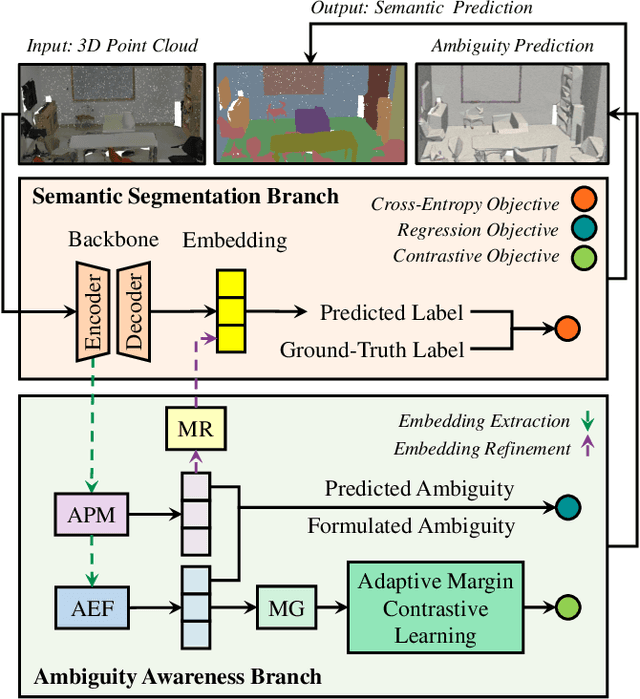
Abstract:This paper proposes an adaptive margin contrastive learning method for 3D semantic segmentation on point clouds. Most existing methods use equally penalized objectives, which ignore the per-point ambiguities and less discriminated features stemming from transition regions. However, as highly ambiguous points may be indistinguishable even for humans, their manually annotated labels are less reliable, and hard constraints over these points would lead to sub-optimal models. To address this, we first design AMContrast3D, a method comprising contrastive learning into an ambiguity estimation framework, tailored to adaptive objectives for individual points based on ambiguity levels. As a result, our method promotes model training, which ensures the correctness of low-ambiguity points while allowing mistakes for high-ambiguity points. As ambiguities are formulated based on position discrepancies across labels, optimization during inference is constrained by the assumption that all unlabeled points are uniformly unambiguous, lacking ambiguity awareness. Inspired by the insight of joint training, we further propose AMContrast3D++ integrating with two branches trained in parallel, where a novel ambiguity prediction module concurrently learns point ambiguities from generated embeddings. To this end, we design a masked refinement mechanism that leverages predicted ambiguities to enable the ambiguous embeddings to be more reliable, thereby boosting segmentation performance and enhancing robustness. Experimental results on 3D indoor scene datasets, S3DIS and ScanNet, demonstrate the effectiveness of the proposed method. Code is available at https://github.com/YangChenApril/AMContrast3D.
VReST: Enhancing Reasoning in Large Vision-Language Models through Tree Search and Self-Reward Mechanism
Jun 10, 2025Abstract:Large Vision-Language Models (LVLMs) have shown exceptional performance in multimodal tasks, but their effectiveness in complex visual reasoning is still constrained, especially when employing Chain-of-Thought prompting techniques. In this paper, we propose VReST, a novel training-free approach that enhances Reasoning in LVLMs through Monte Carlo Tree Search and Self-Reward mechanisms. VReST meticulously traverses the reasoning landscape by establishing a search tree, where each node encapsulates a reasoning step, and each path delineates a comprehensive reasoning sequence. Our innovative multimodal Self-Reward mechanism assesses the quality of reasoning steps by integrating the utility of sub-questions, answer correctness, and the relevance of vision-language clues, all without the need for additional models. VReST surpasses current prompting methods and secures state-of-the-art performance across three multimodal mathematical reasoning benchmarks. Furthermore, it substantiates the efficacy of test-time scaling laws in multimodal tasks, offering a promising direction for future research.
PRISM: Projection-based Reward Integration for Scene-Aware Real-to-Sim-to-Real Transfer with Few Demonstrations
Apr 29, 2025Abstract:Learning from few demonstrations to develop policies robust to variations in robot initial positions and object poses is a problem of significant practical interest in robotics. Compared to imitation learning, which often struggles to generalize from limited samples, reinforcement learning (RL) can autonomously explore to obtain robust behaviors. Training RL agents through direct interaction with the real world is often impractical and unsafe, while building simulation environments requires extensive manual effort, such as designing scenes and crafting task-specific reward functions. To address these challenges, we propose an integrated real-to-sim-to-real pipeline that constructs simulation environments based on expert demonstrations by identifying scene objects from images and retrieving their corresponding 3D models from existing libraries. We introduce a projection-based reward model for RL policy training that is supervised by a vision-language model (VLM) using human-guided object projection relationships as prompts, with the policy further fine-tuned using expert demonstrations. In general, our work focuses on the construction of simulation environments and RL-based policy training, ultimately enabling the deployment of reliable robotic control policies in real-world scenarios.
Exploring Forgetting in Large Language Model Pre-Training
Oct 22, 2024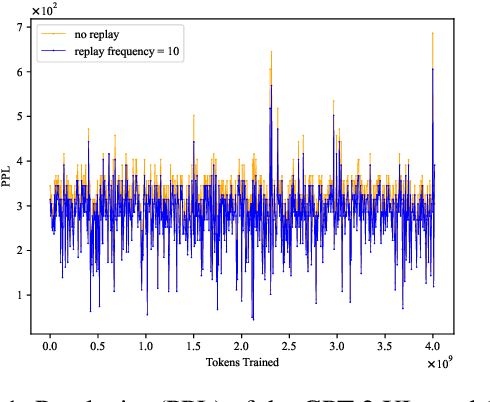
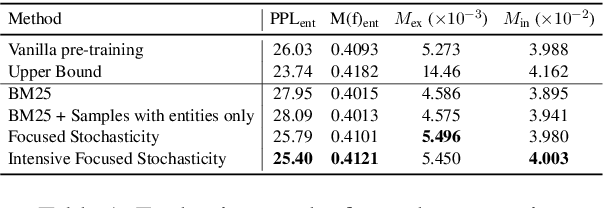
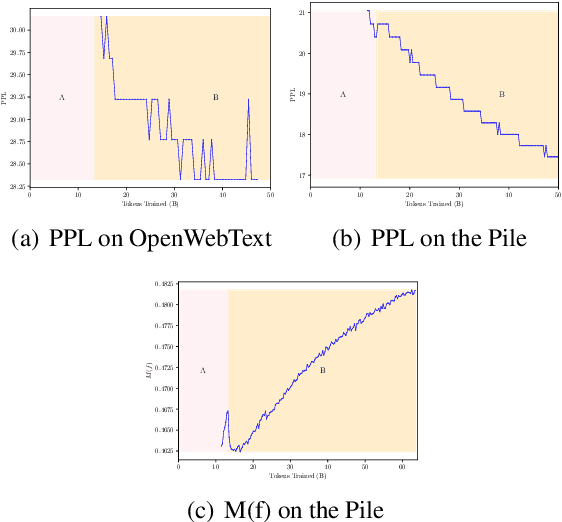

Abstract:Catastrophic forgetting remains a formidable obstacle to building an omniscient model in large language models (LLMs). Despite the pioneering research on task-level forgetting in LLM fine-tuning, there is scant focus on forgetting during pre-training. We systematically explored the existence and measurement of forgetting in pre-training, questioning traditional metrics such as perplexity (PPL) and introducing new metrics to better detect entity memory retention. Based on our revised assessment of forgetting metrics, we explored low-cost, straightforward methods to mitigate forgetting during the pre-training phase. Further, we carefully analyzed the learning curves, offering insights into the dynamics of forgetting. Extensive evaluations and analyses on forgetting of pre-training could facilitate future research on LLMs.
ReconX: Reconstruct Any Scene from Sparse Views with Video Diffusion Model
Aug 29, 2024Abstract:Advancements in 3D scene reconstruction have transformed 2D images from the real world into 3D models, producing realistic 3D results from hundreds of input photos. Despite great success in dense-view reconstruction scenarios, rendering a detailed scene from insufficient captured views is still an ill-posed optimization problem, often resulting in artifacts and distortions in unseen areas. In this paper, we propose ReconX, a novel 3D scene reconstruction paradigm that reframes the ambiguous reconstruction challenge as a temporal generation task. The key insight is to unleash the strong generative prior of large pre-trained video diffusion models for sparse-view reconstruction. However, 3D view consistency struggles to be accurately preserved in directly generated video frames from pre-trained models. To address this, given limited input views, the proposed ReconX first constructs a global point cloud and encodes it into a contextual space as the 3D structure condition. Guided by the condition, the video diffusion model then synthesizes video frames that are both detail-preserved and exhibit a high degree of 3D consistency, ensuring the coherence of the scene from various perspectives. Finally, we recover the 3D scene from the generated video through a confidence-aware 3D Gaussian Splatting optimization scheme. Extensive experiments on various real-world datasets show the superiority of our ReconX over state-of-the-art methods in terms of quality and generalizability.
DreamCinema: Cinematic Transfer with Free Camera and 3D Character
Aug 22, 2024



Abstract:We are living in a flourishing era of digital media, where everyone has the potential to become a personal filmmaker. Current research on cinematic transfer empowers filmmakers to reproduce and manipulate the visual elements (e.g., cinematography and character behaviors) from classic shots. However, characters in the reimagined films still rely on manual crafting, which involves significant technical complexity and high costs, making it unattainable for ordinary users. Furthermore, their estimated cinematography lacks smoothness due to inadequate capturing of inter-frame motion and modeling of physical trajectories. Fortunately, the remarkable success of 2D and 3D AIGC has opened up the possibility of efficiently generating characters tailored to users' needs, diversifying cinematography. In this paper, we propose DreamCinema, a novel cinematic transfer framework that pioneers generative AI into the film production paradigm, aiming at facilitating user-friendly film creation. Specifically, we first extract cinematic elements (i.e., human and camera pose) and optimize the camera trajectory. Then, we apply a character generator to efficiently create 3D high-quality characters with a human structure prior. Finally, we develop a structure-guided motion transfer strategy to incorporate generated characters into film creation and transfer it via 3D graphics engines smoothly. Extensive experiments demonstrate the effectiveness of our method for creating high-quality films with free camera and 3D characters.
AdaCQR: Enhancing Query Reformulation for Conversational Search via Sparse and Dense Retrieval Alignment
Jul 02, 2024Abstract:Conversational Query Reformulation (CQR) has significantly advanced in addressing the challenges of conversational search, particularly those stemming from the latent user intent and the need for historical context. Recent works aimed to boost the performance of CRQ through alignment. However, they are designed for one specific retrieval system, which potentially results in poor generalization. To overcome this limitation, we present a novel framework AdaCQR. By aligning reformulation models with both term-based and semantic-based retrieval systems, AdaCQR enhances the generalizability of information-seeking queries across diverse retrieval environments through a dual-phase training strategy. We also developed two effective approaches for acquiring superior labels and diverse input candidates, boosting the efficiency and robustness of the framework. Experimental evaluations on the TopiOCQA and QReCC datasets demonstrate that AdaCQR significantly outperforms existing methods, offering both quantitative and qualitative improvements in conversational query reformulation.
LGTM: Local-to-Global Text-Driven Human Motion Diffusion Model
May 06, 2024
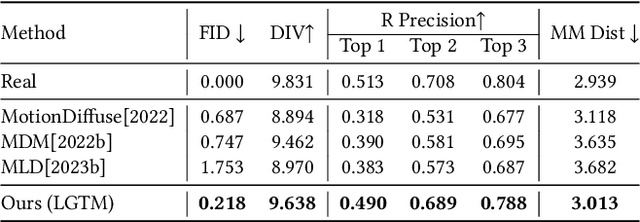


Abstract:In this paper, we introduce LGTM, a novel Local-to-Global pipeline for Text-to-Motion generation. LGTM utilizes a diffusion-based architecture and aims to address the challenge of accurately translating textual descriptions into semantically coherent human motion in computer animation. Specifically, traditional methods often struggle with semantic discrepancies, particularly in aligning specific motions to the correct body parts. To address this issue, we propose a two-stage pipeline to overcome this challenge: it first employs large language models (LLMs) to decompose global motion descriptions into part-specific narratives, which are then processed by independent body-part motion encoders to ensure precise local semantic alignment. Finally, an attention-based full-body optimizer refines the motion generation results and guarantees the overall coherence. Our experiments demonstrate that LGTM gains significant improvements in generating locally accurate, semantically-aligned human motion, marking a notable advancement in text-to-motion applications. Code and data for this paper are available at https://github.com/L-Sun/LGTM
InterFusion: Text-Driven Generation of 3D Human-Object Interaction
Mar 22, 2024Abstract:In this study, we tackle the complex task of generating 3D human-object interactions (HOI) from textual descriptions in a zero-shot text-to-3D manner. We identify and address two key challenges: the unsatisfactory outcomes of direct text-to-3D methods in HOI, largely due to the lack of paired text-interaction data, and the inherent difficulties in simultaneously generating multiple concepts with complex spatial relationships. To effectively address these issues, we present InterFusion, a two-stage framework specifically designed for HOI generation. InterFusion involves human pose estimations derived from text as geometric priors, which simplifies the text-to-3D conversion process and introduces additional constraints for accurate object generation. At the first stage, InterFusion extracts 3D human poses from a synthesized image dataset depicting a wide range of interactions, subsequently mapping these poses to interaction descriptions. The second stage of InterFusion capitalizes on the latest developments in text-to-3D generation, enabling the production of realistic and high-quality 3D HOI scenes. This is achieved through a local-global optimization process, where the generation of human body and object is optimized separately, and jointly refined with a global optimization of the entire scene, ensuring a seamless and contextually coherent integration. Our experimental results affirm that InterFusion significantly outperforms existing state-of-the-art methods in 3D HOI generation.
 Add to Chrome
Add to Chrome Add to Firefox
Add to Firefox Add to Edge
Add to Edge